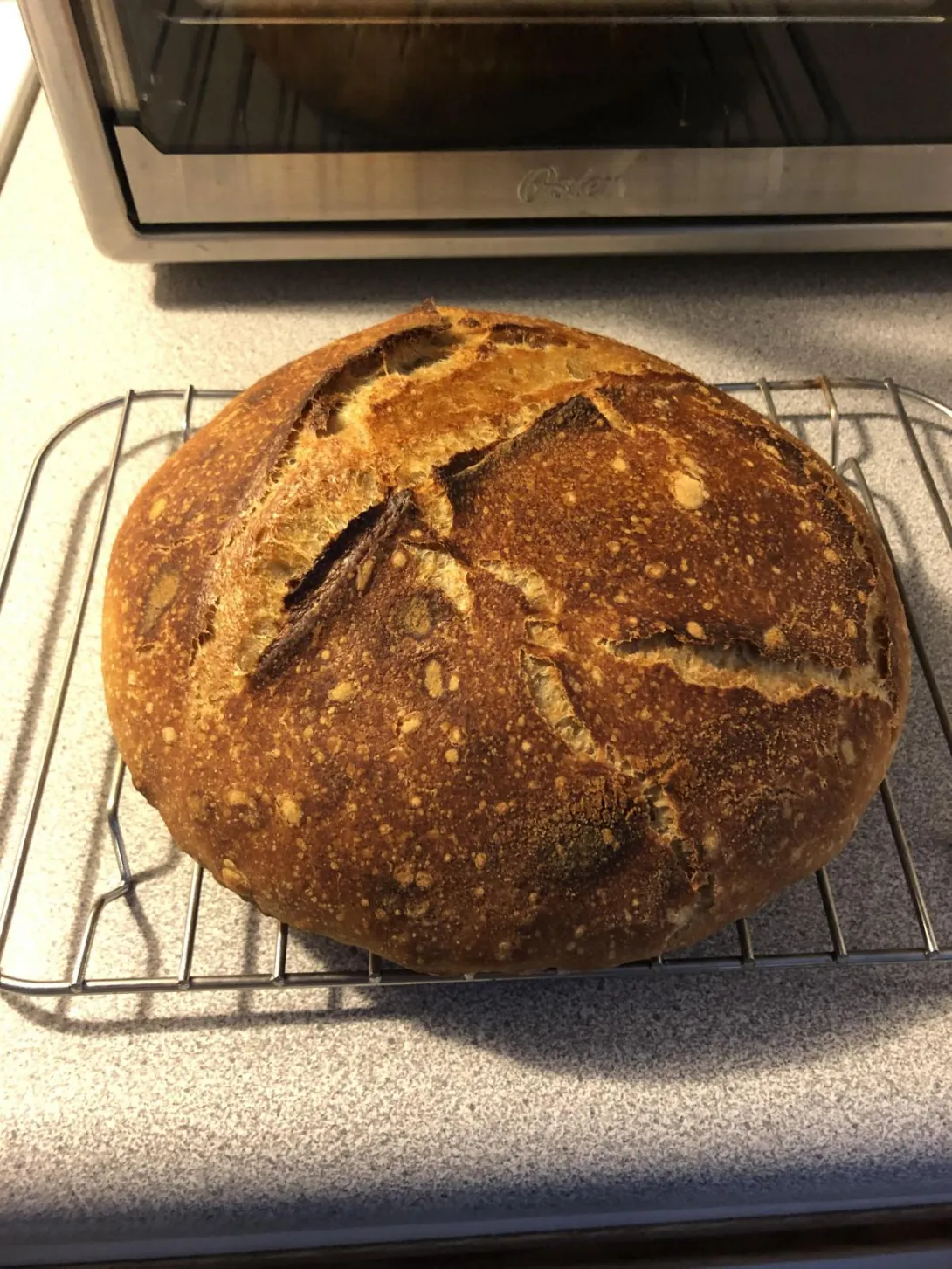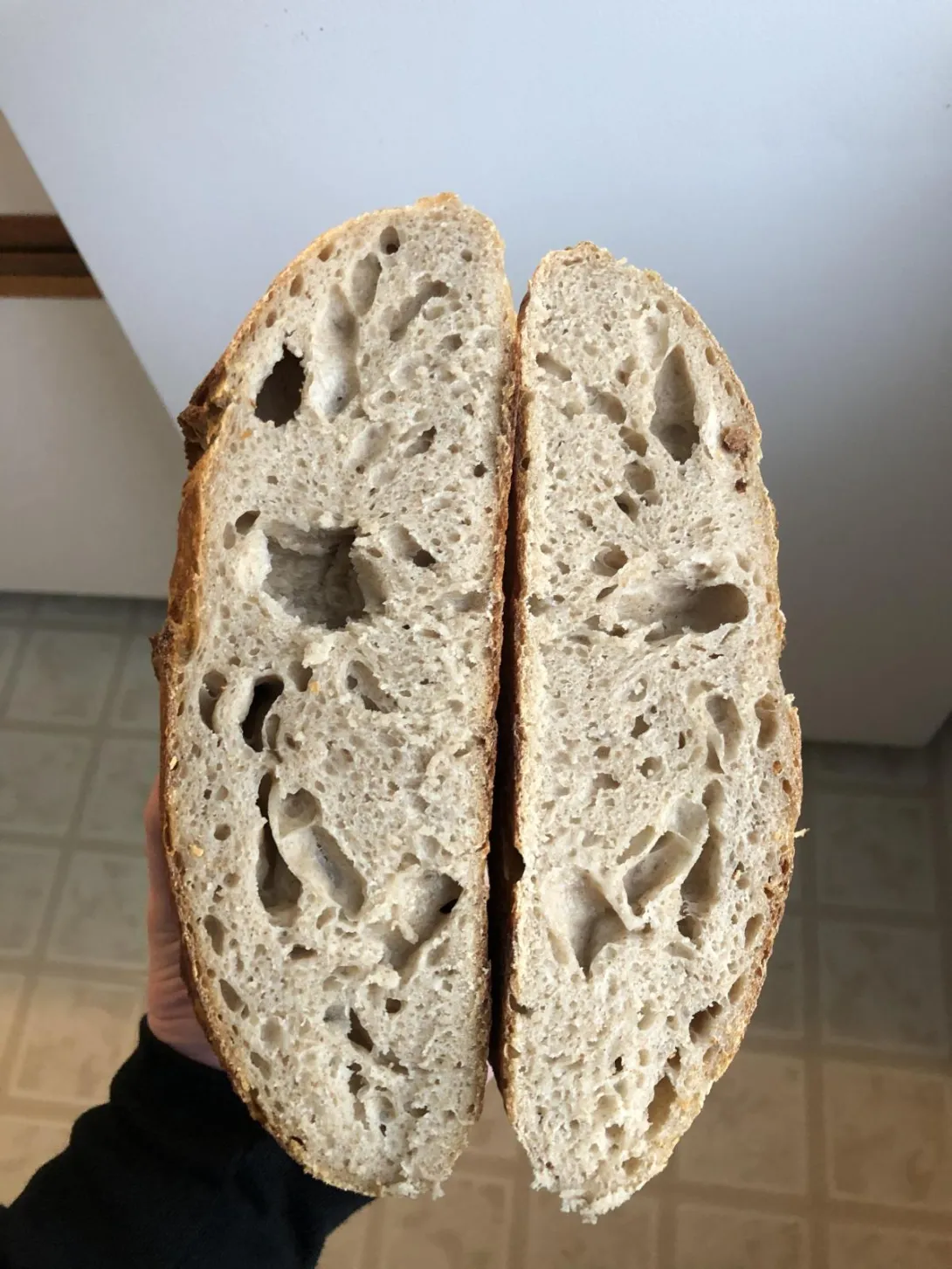My first attempt can be found here:
https://www.thefreshloaf.com/node/67049/first-starter-first-loaf-first-post
My second attempt, I didn’t impress myself as much, but it’s mostly my fault as I changed way too many variables.
second loaf:
400g KA BF
75g KA WW
25g Bobs dark rye flour
395g water
10g salt
100g levain (30/30/30 APF/Rye/WW)
process:
1 hour autolyse
1/2 hour salt and levain
2.5 hours stretch and fold (every 30 min)
4 hour bulk ferment at ~75 degrees
preshape, 1/2hr bench rest, final shape, 16 hour fridge proof
I felt much better this time handling and shaping the dough, even with a higher hydration. The final product did not seem to rise nearly as much as my first loaf. The ear was not as pronounced, and there was other splits in the loaf crust. I also noticed the crumb is a little sticky? Not quite gummy, but sticky.
I think one of the major problems was that I baked it differently. First loaf I put my lodge enameled Dutch oven in the oven, and preheated to 500F for an hour. Unfortunately I noticed some spider webbing in the enamel of the lid the next day. So this time I preheated the oven only to 475F. Then I put the Dutch oven in to warm up for 30 min, then continued the baking steps. I’m definitely going to try my first baking process again for my next loaf. Pretty sure the first 20 min at 500F creates more oven spring?
Any other feedback would be great!


you must have high hydration to achieve good results.(Well....not everybody) Try working with something in the 70-73% range for a bit and see if your result meets your expectations. I think you have too much water for the flour ratios and types you are using. Once you have seen what the results are, decide if there is a benefit to 80%...
Just my opinion, I'm sure that others will differ
Thanks! I think I’ll back down the hydration next time and go back to 500 degrees
Hi, RKangaroo!
I'm a newer baker but do have a thought, if you don't mind.
Your recipe, time, and temperature looks like it's right on the money but the crumb looks classically under-proofed.
It looks under-proofed because of the large tunnel-shaped hole(s), uneven distribution of large and small holes, and dense crumb throughout, especially toward the bottom.
On the other hand, you might simply have degassed with final shape and short 30 minute bench rest before refrigerating.
I might try moving some or all of your four hour rest/bulk ferment time to proof time in your banneton or rising vessel of choice. Then check to see if four hours in the basket is too much such that you are over-proofing and still getting flat and collapsed loaves.
This means rest 30-45 minutes after last stretch and fold. Preshape and shape. Then into the basket for four hours (maybe just three hours?). Then into the Arctic it goes.
I'd be interested in how this works. Can you report back if you try it?
Murph
Thanks Murph! I’ll definitely give that a try. It seems from all the different write ups I’ve seen, a lot of people only bulk ferment maybe 2 hours. Mine didn’t seem to grow or show any bubble formation until the 4-5 hour mark.
you may be right about degassing, too. If you look at my first loaf, there definitely seems to be some disturbance pattern at the bottom of the loaf, likely from poor final shaping.
Hey, RK,
I've become a big fan of The Sourdough Journey on YouTube. I don't know the guy but his long-form videos on his experiments with the Tartine Country Bread (85% hydration!) suits me just fine. I'll bet dollars to doughnuts it will help others as well.
I would recommend to anyone that they commandeer the remote control and soak it in. Read the show notes to skip to relevant parts and check out the comments. He does a really good job as far as I'm concerned.
Tartine Country Bread bulk ferments for ~three hours and proofs for another three-four hours.
The Sourdough Journey has come to the conclusion that the yeast makes the bread, not the baker. Bakers just get in the way. With their shaping, pre-shaping, and final shaping. And worrying. And tinkering. And...
...Not taking notes, controlling variables, and adjusting as needed.
That's why I like his experiments and thats why I suggest you move your bulk ferment time into proof time.
What surprised me is that bulk ferment's purpose is to do some fermenting, of course, but also... to develop the gluten. It is not a time to sit around and watch TV. Get jiggy with your dough. Usually. Depending on recipe.
But that gluten is important. Just as important as nailing the fermentation. What's more, the final hour or two needs careful attendance because yeast grows exponentially.
Yeast doubles and doubles and doubles. In the last hour or two, the yeast could just double their way right through their food and energy source... which is the unfermented flour.
You could go from perfectly fermented to flat-as-a-pancake in 30-45 minutes. Yeeks!
Everybody... everybody... changes a sourdough recipe. The principles remain the same: Ferment your flour to perfection, shape (lightly) into whatever form you need, and bake such that any unfermented flour that should be left is entirely eaten by heat-excited yeast before they roast to death in the oven.
I hope you wouldn't mind letting me know how you make out because I want to learn more. In the meantime...
All my best,
Murph